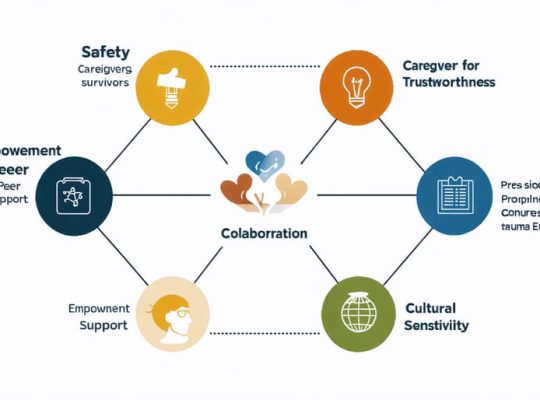Working in trauma-focused professions carries profound emotional risks that extend far beyond the workplace. While both secondary and vicarious trauma impact caregivers and healthcare professionals who witness others’ suffering, understanding their distinct characteristics is crucial for maintaining mental wellness and professional effectiveness. Secondary trauma often develops through direct exposure to others’ traumatic experiences, creating immediate emotional responses and stress symptoms. In contrast, vicarious trauma emerges gradually through the cumulative impact of empathetically engaging with trauma survivors, fundamentally altering how professionals view themselves and the world around them. Recognizing these nuances is essential, as how trauma shapes mental health extends beyond individual survivors to affect those who support them. This understanding empowers caregivers and professionals to implement targeted self-care strategies and maintain healthy boundaries while continuing their vital work supporting others through trauma recovery.
Understanding Secondary Trauma

Signs and Symptoms of Secondary Trauma
Recognizing the signs of secondary trauma is crucial for early intervention and self-care. Common physical symptoms include headaches, fatigue, and changes in sleep patterns. You might notice your heart racing more often or experience unexplained muscle tension, particularly after difficult encounters with traumatized children.
Emotional indicators can be subtle at first but tend to intensify over time. You may feel overwhelmed by others’ stories, experience unexpected mood swings, or find yourself becoming increasingly irritable with loved ones. Many caregivers report feeling emotionally numb or disconnected from their usual activities and relationships.
Behavioral changes often accompany these symptoms. You might catch yourself avoiding certain situations, withdrawing from social activities, or having difficulty maintaining professional boundaries. Some caregivers notice they’re constantly thinking about their clients’ traumatic experiences, even during personal time.
Professional impact can manifest as decreased motivation, reduced empathy, or questioning your effectiveness as a caregiver. You might experience intrusive thoughts about traumatic stories shared by those in your care or find it challenging to separate work concerns from your personal life.
Impact on Daily Life
Secondary trauma and vicarious trauma can significantly impact both personal and professional aspects of daily life. Many caregivers and professionals find themselves bringing work-related stress home, which can affect relationships with family and friends. You might notice changes in sleep patterns, difficulty maintaining boundaries between work and personal life, or feeling emotionally drained even during leisure activities.
At work, these forms of trauma can lead to decreased productivity, compassion fatigue, and challenges in maintaining professional relationships. Teachers might find it harder to connect with students, while healthcare professionals might struggle to provide the same level of emotional support they once did.
Common daily life challenges include:
– Difficulty enjoying previously pleasurable activities
– Changes in eating habits
– Increased irritability with loved ones
– Withdrawal from social situations
– Persistent anxiety about work-related situations
– Physical symptoms like headaches or fatigue
Understanding these impacts is crucial because they often develop gradually. Many professionals initially dismiss these changes as ordinary stress until they significantly affect their quality of life. Recognizing these effects early can help in seeking appropriate support and implementing necessary lifestyle adjustments.

Exploring Vicarious Trauma
Recognizing Vicarious Trauma
Recognizing vicarious trauma often begins with noticing subtle changes in how we view ourselves and the world around us. As one school counselor shared, “I found myself becoming increasingly pessimistic about the world, even when I was away from work.”
Common signs include feeling emotionally drained after hearing about traumatic experiences, having recurring thoughts about others’ trauma stories, and experiencing changes in your worldview or sense of safety. You might notice yourself becoming more protective of your own children or feeling heightened anxiety about their safety.
Physical manifestations can include disrupted sleep patterns, increased irritability, difficulty concentrating, and feeling physically tense. Many professionals report experiencing intrusive thoughts about the traumatic stories they’ve heard, even during personal time.
Emotional indicators often involve feeling overwhelmed by others’ pain, questioning your professional effectiveness, or experiencing a diminished sense of hope. You might find yourself becoming emotionally distant from loved ones or having trouble maintaining professional boundaries.
Remember, experiencing these symptoms doesn’t indicate weakness – it shows you’re human and deeply care about those you help.
Long-term Effects
The long-term effects of trauma can profoundly impact how we view ourselves and the world around us. For those experiencing vicarious trauma, these changes often develop gradually and can significantly alter core beliefs and personal values. Many professionals find themselves questioning the basic goodness of people or struggling to maintain optimistic perspectives about the future.
Parents, teachers, and healthcare workers might notice shifts in how they view safety, particularly regarding children. They may become hypervigilant about their own children’s safety or feel increasingly pessimistic about society’s ability to protect its vulnerable members. These changes can affect personal relationships, parenting styles, and professional decisions.
It’s important to recognize that these alterations in worldview aren’t a sign of weakness but rather a natural response to repeated exposure to others’ trauma. Understanding these changes is the first step toward addressing them and maintaining a balanced perspective while continuing to provide compassionate care to those in need.
Key Differences and Prevention Strategies
Self-Care Practices
Prioritizing self-care is essential when working with traumatized individuals, especially children. Start by establishing clear boundaries between work and personal life – this might mean setting specific “work-free” hours or creating dedicated spaces for relaxation at home.
Regular exercise, mindfulness practices, and adequate sleep form the foundation of emotional resilience. Consider incorporating activities like yoga, meditation, or simple breathing exercises into your daily routine. These practices can help process challenging emotions and maintain mental clarity.
Building a strong support network is crucial. Connect with colleagues who understand your experiences, join professional support groups, or seek regular supervision. Don’t hesitate to learn new mental health crisis techniques to feel more confident in challenging situations.
Make time for activities that bring joy and renewal – whether it’s reading, gardening, art, or spending time with loved ones. Remember, self-care isn’t selfish; it’s necessary for sustainable caregiving. Consider keeping a journal to track your emotional responses and identify early signs of stress or overwhelm.
Regular professional counseling can provide additional support and strategies for managing the emotional impact of your work. Remember, seeking help is a sign of strength, not weakness.

Understanding the distinction between secondary and vicarious trauma is crucial for maintaining your emotional well-being while caring for others. Remember that experiencing these responses is natural and doesn’t reflect any weakness or inadequacy on your part. By recognizing early warning signs and implementing regular self-care practices, you can continue your vital work while protecting your mental health.
Take proactive steps to establish boundaries, connect with supportive colleagues, and engage in activities that replenish your emotional reserves. Consider seeking professional support when needed – it’s a sign of strength, not weakness. Your well-being matters not only for yourself but also for those you care for.
Stay mindful of your emotional responses, practice self-compassion, and remember that taking care of yourself is an essential part of being able to care for others effectively.







